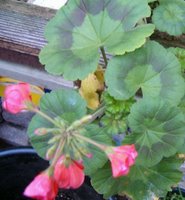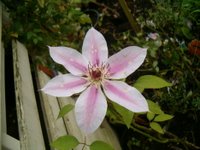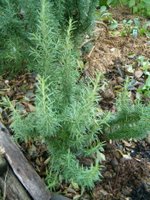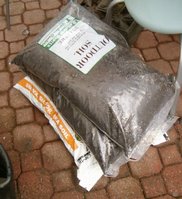







Wind Storms and Organic Sweet Corn
As I write this, gale force winds are battering the British Columbia coast. The ferry service has stopped running, so we’re isolated here on Gabriola Island, along with the residents of all the other Southern Gulf Islands. Trees have fallen to block highways and power lines have toppled over, cutting off electricity to thousands of homes on the islands and the mainland.
We’re lucky, we still have power so we listen to the radio to get a grasp on the situation. Over 100 km an hour winds with more rain and storm to come. This is about as bad as it gets on Canada’s western coast. No hurricanes here and hopefully no tsunamis. But tell that to the couple down the road whose house was just about cut in half by a fallen cedar.
Fall and winter are the seasons when we value evergreens. Our garden has been levelled and copious amounts of composted manure have been applied. This past week Sara bought more soil, since she is planning to replant her Butterfly Bush (freshly pruned) into a larger container. We’ll need to assemble the neighborhood brigade to do that monumental job, to be sure.
A late blooming flower stands guard over the mostly brown garden. By contrast, things Down Under are just getting started. We got another e-mail from Eloise and John. Their sweet corn growing operation is picking up speed and they report fast germination and growth, after applying the Advanced Nutrients products that we recommended to them.
“In addition to treating the soil around the roots of our young corn plants with Piranha, Tarantula, and Voodoo Juice—in order to colonize their root systems with beneficial fungi, bacteria, and friendly microbes, respectively—we are also starting to feed our seedlings with Iguana Juice Grow.”
“We noticed on the Advanced Nutrients website, that the application rate for Iguana Juice has recently been reduced from 15 mL/L to 3.5 mL/L. This makes it much more economical, without losing any of its nutrient value and growth enhancement potential.”
“We had to do our homework very quickly in a race against the clock. We learned that there were three basic types of sweet corn to be had: SH2 or supersweet, SUSU or normal sugary, and SESE or sugary enhancer. Some traditional growers still use the old classification of white, yellow, and bi-colored.”
“We chose a yellow corn variety, a SESE or sugary enhancer, called Maple Sweet, in honor of you guys. It takes only 70 days from seed to harvest (some other varieties take as long as 86 days) and it grows large cobs that are resistant to disease. We can attest to its delicious flavor, since friends of our have grown this variety and had us over for dinner last year at harvest time.”
“We decided to grow just one variety since we have limited space and it’s not a good idea to plant different varieties right next to each other. Cross pollination has to be taken into account.”
“It is recommended to plant the corn after all danger of frost has passed. Corn requires at least 8 hours of sunlight per day, at a soil temperature no lower than 60-65º F. Soil pH should be around 6.0 or 6.5. If this needs to be raised, we’ve stocked up on Advanced Nutrients pH Up; if it needs to be lowered, we have pH Down on hand.”
“We’ve planted fairly deep, about a foot apart, in well-drained soil. Since we’re an island, New Zealand soil is quite sandy, but we’re far enough away from the ocean, that salt is no problem. We’ve been composting all winter in preparation for this, so we’ve added a thick layer of organic compost to provide the rich loam necessary for good horticulture.”
“The compost wasn’t quite enough, so we replenished it with quite a bit of composted horse manure from a nearby farm. I got the idea from you, Sara, I hope you don’t mind.”
“The Genetic Engineering controversy is raging here right now. It seems that the successful use of Bt sprays in organic gardening gave the idea to the genetic engineers to add the genes that produce BT toxins to the corn plants. Millions of hectares in North America are planted with corn that is genetically engineered to kill corn borers with Bt toxins.”
“Then we read elsewhere that a large percentage of consumers in France have stopped buying corn, because they’re afraid that it is genetically engineered. New Zealand consumers feel the same way. That’s why organic produce is so popular here right now.”
“We’ve talked to the technical guys at Advanced Nutrients and commenced a regimen of Barricade, and Scorpion Juice. The potassium silicate in Barricade literally makes the cells of our sweet corn plants resistant to diseases and pests from the inside out.”
“By spraying with Scorpion Juice, we provide our corn plants with induced systemic resistance, to many pests and pathogens. We’ve read about Protector, and wish that it would also be available, but the tech guys explained that until the labelling argument is settled, Advanced Nutrients had to stop selling it.”
“We spend every night reading the entries in Advancedepedia very carefully, in order to find out about all the wonderful products available from Advanced Nutrients.”
“Tim and Sara, you know that you’ll have to pack up your two wonderful kids and visit us at harvest time, now don’t you? There’s nothing like the taste of freshly picked sweet corn as the kernel explodes on your tongue.”
With weather like this, a trip out of here sounds more and more tempting each day.
posted by Tim at
10:32 PM
![]()

0 Comments:
Post a Comment
<< Home